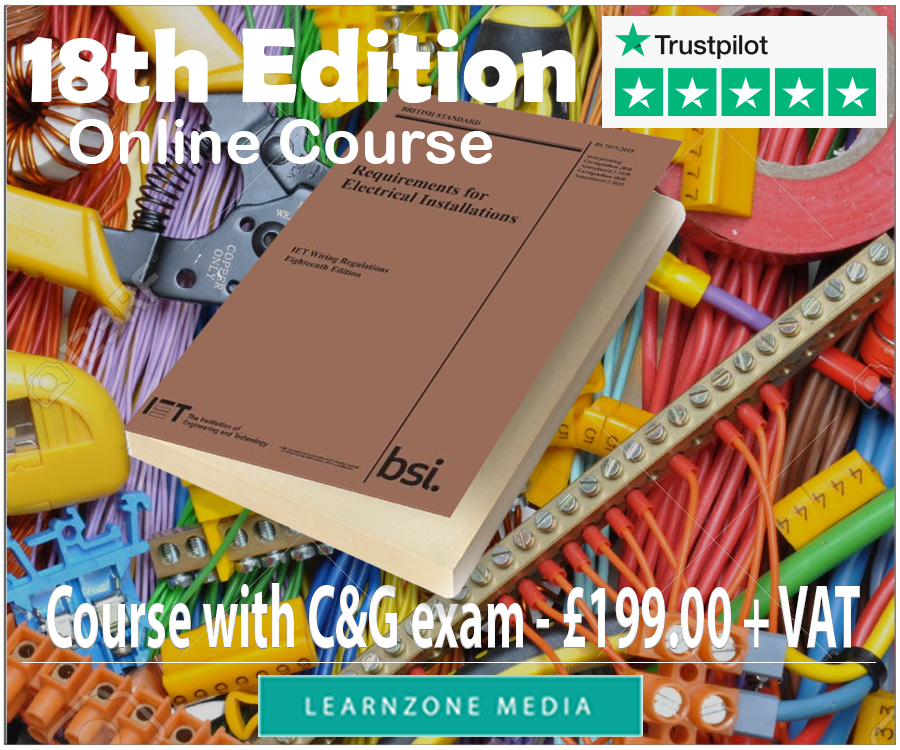18th Edition Exam Questions
We have compiled a selection of questions similar to the ones found in the real C&G 2382-22 exam.
The answers for these question scan be fund on the following page.
Do not forget - the 18th Edition exam consists of 60 questions. The allowed time for the 18th Edition online exam is two hours. This is considered not to difficult if you spend time preparing yourself adequately.
In order to understand and be able to answer these exam practice questions, it is very important that you work your way through the Wiring Regulations book properly, and try to locate the answers within.
![]() Do not forget - the table of contents is your best start. It is allowed to pencil in any kind of notes and remarks that you may fund helpful.
Do not forget - the table of contents is your best start. It is allowed to pencil in any kind of notes and remarks that you may fund helpful.
18th Edition Questions:
Part 1
1. State examples of installations within the scope of BS 7671.
2. Identify particular requirements for specific installations and locations.
3. Identify the excluded installations from the 17th Edition of Wiring Regulations.
4. State the relationship of BS 7671 to statutory regulations.
5. State the requirements regarding to protection for safety, design, selection, erection and verification of electrical installations within the regulations.
Part 2
1. Define what "Bonding conductor" is.
2. Define what "Busbar trunking system" is.
3. What is a "Class II equipment"?
4. What is an "Extraneous-conductive part"?
5. Define what "SELV" means.
6. What is a "Residual current"?
7. Define what "Nominal voltage" is.
8. Define "Live part".
9. Define the meaning of "Earth fault loop impedance".
10. Define what "CPC" is.
Part 3
1. State all external influences that affect the selection of equipment and installation methods.
2. State the number and type of live conductors.
3. State the source and characteristics of required for safety and standby systems.
4. What is the need to divide installations into circuits?
5. State the need for the maintainability of electrical installations.
Part 4
1. What is the difference between Basic Protection and Fault Protection?
2. State four types of protective measures.
3. Describe the methods of basic and fault protection regarding Automatic Disconnection of Supply (ADS).
4. State the difference between overcurrent and fault current.
5. State the maximum disconnection time for a.c. low voltage final circuits not exciding 32A.
Part 5
1. State the need for compliance with standards.
2. Describe the need for diagrams and warning notices and labels.
3. How are live conductors in a 3 phase circuit identified?
4. State the method for selecting the correct type and size of the Main Equipotential Bonding Conductor.
5. State the methods for connecting the main earthing terminal to Earth in electrical installations.
Part 6
1. State the need for initial verification.
2. State five items to be checked during the inspection process.
3. State the minimum values of insulation resistance.
4. State the requirements for Periodic Inspection and Testing.
5. Describe in which case the Electrical Installation Certificate is to be used.
Part 7
1. State the requirements for Zone 1 in a location containing a bath or shower.
2. Describe the requirements for plugs and socket-outlets in caravan/camping and similar locations.
3. Describe the RCD requirements for Floor and Ceiling Heating systems.
4. State the requirements for Zone 3 in rooms and cabins containing sauna heaters.
5. State the requirements for the installation of electrical equipment in Zone 1 of swimming pools and other basins.
Appendices
1. What does the specification of "BS 88" stands for?
2. When it comes to classification of external influences, what does the first letter stands for?
3. What is the maximum value of allowed voltage drop in low voltage installations supplied directly from public low voltage distribution systems?
4. After completing an Electrical Installation certificate (EIC) to whom it will need to be given a copy?
5. What does the specification of "BS EN 60898" stands for?





